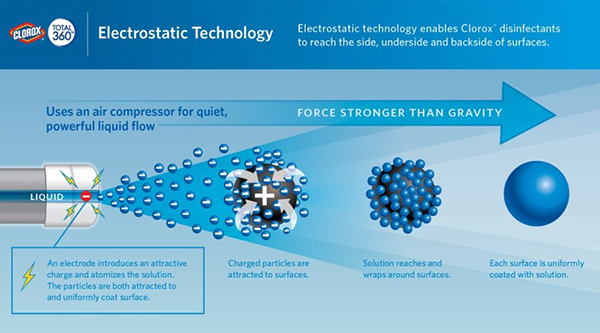A: It is an industrial disinfecting method used after outbreaks (such as norovirus outbreaks in a pre-COVID-19 era).
It is typically not intended for home use. A few important things to know.
Cleaning refers to the manual removal of visible dirt. Disinfecting refers to removal of infectious components after mechanical cleaning has been conducted. In between is sanitizing, the removal of some (but not all) infectious components.
Electrostatic cleaning involves more than misting or fogging, which results in a spray of chemical agents. The spraying relies on gravity to distribute on surfaces (this is sometimes referred to as electric cleaning although this is not the official term). Electrostatic cleaning, on the other hand, charges the chemical droplets. Since most surfaces are neutral (negative/no charge), the solution will be positively charged and thus attracted to the surface. The droplets also disperse and repel each other, making it easier to cover surfaces.
The basics of electrostatic cleaning.
1-A special liquid cleaning solution is used in the electrostatic device. Such solutions are those that are known to be disinfecting agents for COVID-19, but specialized for electrostatic equipment.
2-As the solution is prepared to leave the device it is combined with air (to make a spray) and charged by an electrode (to create an attractive electrical charge) so that it can better adhere to surfaces. While this video demonstrates this with a negative charge (most agree that the charge would be positive), it is a good visualization of how this works. It coats surfaces rather than relies on gravity alone.
Here is also a simple explanation.
3-Different solutions vary, but typically the time to reenter the space after disinfecting is minimal, allowing for quick turnaround time.
4-Protective equipment is required for this method so that the solution does not enter the eyes, nose, mouth as well as other surface areas. These are chemicals that can harm us (as well as the coronavirus). These methods are never intended to be sprayed directly on the human body (just to be clear!).
5-This method is best employed by professionals. However, owners of smaller rental properties are employing these methods to reassure customers that properties are safe. These methods are not recommended for home disinfecting and are beneficial in high volume/high touch environments where multiple individuals interact and/or healthcare environments where the likelihood of dispersed infectious components is high (gyms, daycare facilities, offices, schools, nursing homes).
The bottom line: Electrostatic cleaning may be beneficial for hospitals, hotels, or high volume rental properties, however it is typically not recommended for home use. Follow the CDC guidelines for cleaning and disinfection of surfaces: 1) Clean with soap and water, 2) Use an EPA registered disinfectant; 3) Launder washable items with warm/hot water; 4) Wipe down any smaller surfaces (such as electronics) frequently; and 5) Hand washing, hand washing, hand washing. And if someone is sick, isolate, use separate linens and food supplies, and spread out shared bathroom use (with frequent cleaning).
We all want clean homes, but for now, stick to the fundamentals: clean, disinfect, launder, wash hands…repeat.
Stay safe. Stay sane.
~Aparna



